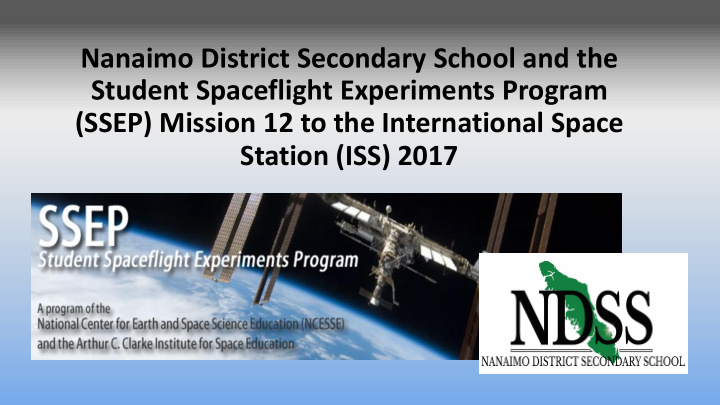



Nanaimo District Secondary School and the Student Spaceflight Experiments Program (SSEP) Mission 12 to the International Space Station (ISS) 2017
Directors: • Mary Anne Perkins SSEP Mission 12 Co-Director Science / Head Coordinator E-mail: maperkins@sd68.bc.ca • Martha Parker SSEP Mission 12 Co-Director Proposal Coordinator E-mail: mparker@sd68.bc.ca • Beverly Long SSEP Mission 12 Co-Director Mission Patch Design E-mail: blong@sd68.bc.ca
What is the Student Spaceflight Experiments Program (SSEP)? • A program of the National Center for Earth and Space Science Education (NCESSE) in the U.S., and the Arthur C. Clarke Institute for Space Education internationally. • SSEP is enabled through a strategic partnership with NanoRacks, LLC, working with NASA under a Space Act Agreement as part of the utilization of the International Space Station as a National Laboratory. • SSEP provides an opportunity to implement a systemic, high caliber STEM education program tailored to local curricular need, which immerses a community of grade 5-16 students in every facet of authentic research. • Designed to be a national model for inspiring and engaging the next generation of American and Canadian scientists and engineers, and addressing science literacy.
Who is involved? • Approximately 500 students at NDSS • Over 20 staff at NDSS (Teachers and Administrators) • Sponsors and Donors include Nanaimo Ladysmith Public Schools, BC Hydro, Magellan Aerospace and The Blue Moon Fund (total of $24,000 USD) • Island Savings Credit Union additional sponsorship • Support/Mentorship from researchers and scientists from Vancouver Island University, Elder College and the Pacific Biological Station
Timeline: • May – August 2017: – secured funding from local community, businesses, and philanthropic organizations and approval of Implementation Plan. • September 5 – November 3, 2017: 9 weeks of Experiment Design and Proposal Writing • November 15, 2017 : Deadline for Finalist Proposals from our Local Step 1 Review Board • December 14, 2017: Flight Experiment Formally Selected by NCESSE Step 2 Review Board • January 19, 2018, Through 2 Months Before Launch: Student Team Can Continue to Refine and Optimize Their Experiment • March 9, 2018: Deadline for NCESSE to Receive Mission Patch(es) to Fly to ISS • Launch Date: to be determined, expect Spring 2018, Time on ISS: approximately 4-6 weeks • Return to Earth: Current Target: Summer 2018 • Late June 2018: National Conference at the Smithsonian National Air and Space Museum
Benefits? • STEAM education – Science, Technology, Engineering, Arts and Mathematics. • Complements the inquiry-based approach to learning and the goals of the BC Science curriculum/core competencies • Promotes active engagement of students and allows for personalized learning of the curriculum and content, • Incorporates place-based approach to science learning, First Peoples knowledge , respect for the natural world; connections to their ecosystem and community • Designed to equip students for the 21 st Century , so that they have the thinking skills necessary for engaging in the pursuit of discovery and innovation. • Students develop a lifelong interest in science and the attitudes that will make them scientifically literate citizens who bring a scientific perspective, as appropriate, to social, moral, and ethical decisions and actions in their own lives, culture, and the environment
Mission Patch Design Contest: • Two patches will be designed • One from students at NDSS • One from the 10 feeder elementary schools to NDSS • They will accompany the experiment and be returned to the school
The Experiment: • Students in grades 8 to 12, will be working in groups of 3-5 to design experiments that will compete to be tested in the micro gravity environment on the ISS. • One will be chosen by the SSEP scientists and will be sent up to the ISS in the spring of 2018 to be performed by the astronauts . • These students will then be performing the same experiment here as a control in a gravity environment.
• Students will be designing and writing a research proposal, working with mentors in their community, that flows from the following Inquiry Question : "What physical, chemical, or biological system would I like to explore with gravity seemingly turned off for a period of time, as a means of assessing the role of gravity in that system?“’
• Students will have the opportunity to attend the launch from NASA’s Kennedy Space Center in Florida and to present their study at their own research conference at the Smithsonian National Air and Space Museum in Washington, DC, in late June/ early July 2018.
Website: http://ssep.ncesse.org/ http://www.nanaimobulletin.co m/news/nanaimo-students-on-a- countdown-to-launch-science- experiment-into-space/ https://www.gofundme.com/4rq 3a-title
"The Student Spaceflight Experiments Program [or SSEP] is a program of the National Center for Earth and Space Science Education (NCESSE) in the U.S. and the Arthur C. Clarke Institute for Space Education internationally. It is enabled through a strategic partnership with DreamUp PBC and NanoRacks LLC, which are working with NASA under a Space Act Agreement as part of the utilization of the International Space Station as a National Laboratory. http://nanoracks.com/ http://www.dreamup.org/
Recommend
More recommend